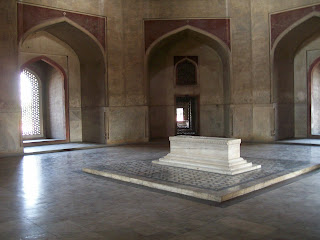
Bec (pictured above teaching) is an Aussie who has finished university and wanted to do something (a) different and (b) useful before she went into full-time work. She featured on the Australian Channel 7 National News last week. She had been filmed whilst the Channel 7 news team were covering the Commonwealth Games. The Aussie CWG athletes made a very generous donation to the work of Asha, so the news crew wanted to follow up with the work on an Aussie in the slums of Delhi. So if you saw that news broadcast, that's Mayapuri. I worked with Bec for a few days and then took over from her in Mayapuri. She's now having a bit of a holiday in central India, before heading back to the Land of Oz to look for a 'real' job.

Jess (pictured above sitting on the wall surrounding a 12th century tomb near our flat) is a Kiwi and is considering studying to be a teacher. She works in the Zhakira slum, which is over an hour's drive from where we live. Her classroom is a miniscule concrete box without windows, perhaps 3m x 3m. When there are more than 10 pupils on the floor, it becomes an impossible environment in which to teach. Although Aussies traditionally mock the Kiwi accent, Jess' Indian students have never noticed until her lesson on Friday. In a lesson about food, she wrote the word 'bitter' on the board and pronounced it for them. They all told her that she had mispelt it: No, miss, butter is spelt with a 'u' not an 'i'. She kept repeating it over and over again, trying to convince them that 'bitter' was a different word from 'butter'. We'll see how they do on the test. :-)
Anjuli is from England, and to make our lives so much easier, speaks fluent Hindi. The rest of us are struggling. Anjuli is a qualified language teacher and will be working with Asha for a year, designing curricula for different levels, overseeing lesson plans and making the lives of ETVs much easier.
All my flatmates are easy to get along with. We take turns to get up early to pump the water. Sometimes someones cooks and sometimes no-one cooks. I'll write more about food later. Now that Bec has left, we each have a bedroom to ourselves, but that will only last for two more weeks, then new people arrive.
Our routine is to get up early or later (depending on who's doing the water), have breakfast and wait for the driver, who takes us all to the Asha office. Those of us who are teaching in the slums (me, Bec and Jess) photocopy our worksheets, gather our resources like extra copy books and pencils, do any admin that needs doing (like paying the rent) then we head off to Mayapuri and Zhakira. We teach all day then find our own way home. By 6pm it is dark, but our market is open until about 9pm or thereabouts, so we sometimes do a little grocery shopping before dinner. Then it's lesson preparation for the next day, followed by a shower to remove all the grime, sweat and dirt accumulated from a day in a Delhi slum. After that it's a bit of a chat if we're in the mood, or we logon to the Internet to update blogs, send emails and so on. By 10 or 11pm the whole household is asleep, getting ready for another Delhi day!
















































